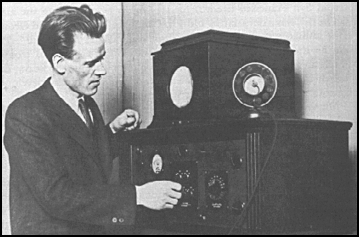Philo T. Farnsworth


"While the great minds of science, financed by the biggest companies in the world, wrestled with 19th century answers to a 20th century problem, Philo T. Farnsworth, age 13, dreamed of trapping light in an empty jar and transmitting it, one line at a time, on a magnetically deflected beam of electrons."
You are looking at a video screen. But do you have any idea at all who invented video?It seems ironic. Inventors are such a big part of the American Legacy. The Information Age began when Samuel B. Morse tapped out "What hath God wrought?" on the first telegraph; the music business began when Edison spoke the words, "Mary Had a Little Lamb" and heard them played back moments later from a tin-foil drum. The telephone arrived when Mr. Bell spilled some acid on his pants and shouted, "Mr. Watson, come here, I need you!" -- and Mr. Watson heard him on a contraption in another room. Hollywood began when Edison filmed a sneeze.
Television, represents the culmination of all the inventions that went before it: the marriage of movies and radio; sight and sound merged with the electromagnetic spectrum. The crowning achievement of an age of invention.
But who among us can name the man who invented it?
Video, in all it's forms, is the most pervasive medium ever concieved. It's not just television, which is so omnipresent now that you can't even wait to board an airplane without being compelled to watch CNN or a soap opera. It's computers, too, which are now turning into a mass medium in their own right. And every computer in the world uses video as it's primary display device.
But how many of us whose lives are shaped by this device have any idea of the genius that concieved it?
The corporate doctrine within the communications industry would have us believe that television was far too complex a concept to have been "invented" by a single individual working alone, in a garage perhaps, in the manner of Edison and Bell (or Hewlett & Packard and Jobs & Wozniak....). They would rather us believe that the medium evolved over a period of time, finally emerging whole in the late 1940's from the great laboratories of the industrialized world--just in time for Uncle Milty, Gunsmoke, and Dinah Shore.
That television ever was an invention is a notion that seems to surprise most folks. It just seems like it's always been there, like God and McDonald's. There is certainly no folklore associated with its origins. This void in our popular mythology is unfortunate, because in fact, the true origin of electronic video is one the most fascinating stories of the 20th century...and features one of the era's most intriguing and enigmatic characters: Philo T. Farnsworth.
Farnsworth was a 14 year old Mormon farm boy from Rigby Idaho with virtually no knowledge of electronics when he first sketched his idea for electronic video on a black board for his high-school science teacher in 1922. 15 years later, that teacher would re-create that sketch as part of his testimony in patent litigation between Farnsworth and the giant Radio Corporation of America. Farnsworth eventually won all of his extensive litigation with RCA, and became the first Independent Inventor EVER awarded a royalty-paying patent license from RCA.
But that's just PART of the story.
In the weeks that follow, the life story of Philo T. Farnsworth will be recreated in multiple installments here on this site on the World Wide Web. The material you will find here was compiled during the 1970's from exhaustive interviews conducted with Farnsworth's widow, Elma Gardner "Pem" Farnsworth, and the inventor's oldest son, Philo T. Farnsworth III, himself an inventor. These interviews were reconciled against the existing historical record to produce the account you will find here, which was first published in 1977 in a now defunct "alternate media" journal called TeleVisions. The entire effort to recreate Farnsworth's story and integrate it with the "historical" record was part of a larger effort to produce a "movie for television about the boy who invented it." which has yet to be funded or produced.
The illustrations that will accompany this material are mostly taken from the personal archives of Mrs. Farnsworth, who has survived her husband since his death in 1971. In 1990, she completed her own extensive biography of her late husband entitled "Distant Vision: Romance and Discovery on the Invisible Frontier" which is available from Pemberly Kent Publishers 2121 Garfield Avenue, Salt Lake City, UT 91808. The book's publishing was timed to coincide with the unveiling of a statue of Farnsworth that now stands in the Statuary Hall of the Capitol Building in Washington DC, one of two such statues dedicated by the State of Utah; the other is a likeness of Brigham Young.
It seems appropriate to re-tell this story on World Wide Web, even if it doesn't lend itself to a lot of fancy CGI-Interactive bells and whistles, because in a real sense, the state of Internet and the Web is very analogous to the state of Farnsworth's invention during the 1920s and '30s. There is much that we can learn from his story.
So let us begin with...
 1977, 1995 Paul Schatzkin; All Rights Reserved
1977, 1995 Paul Schatzkin; All Rights Reserved